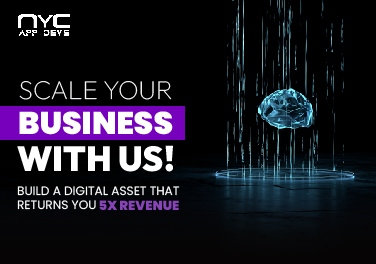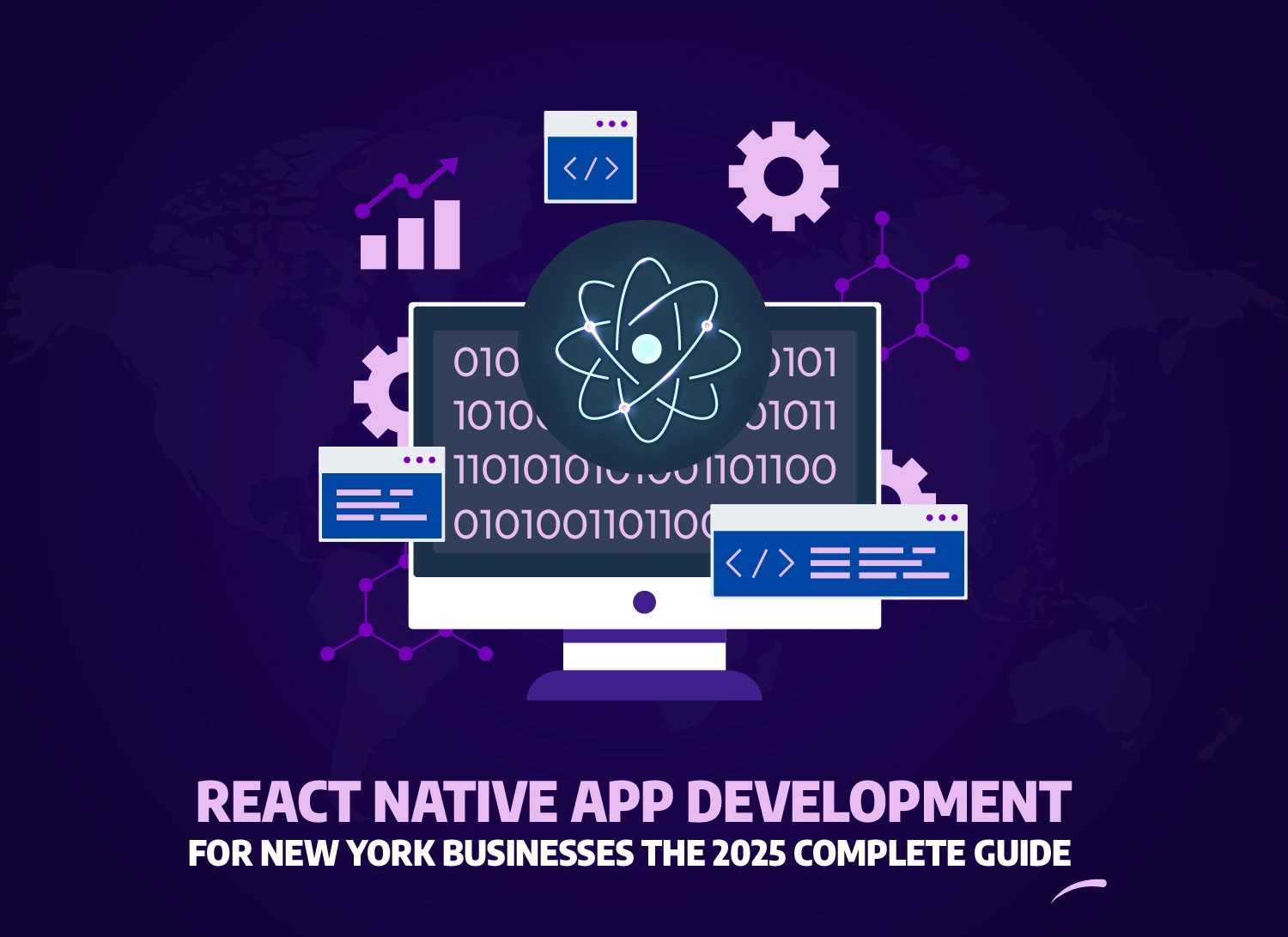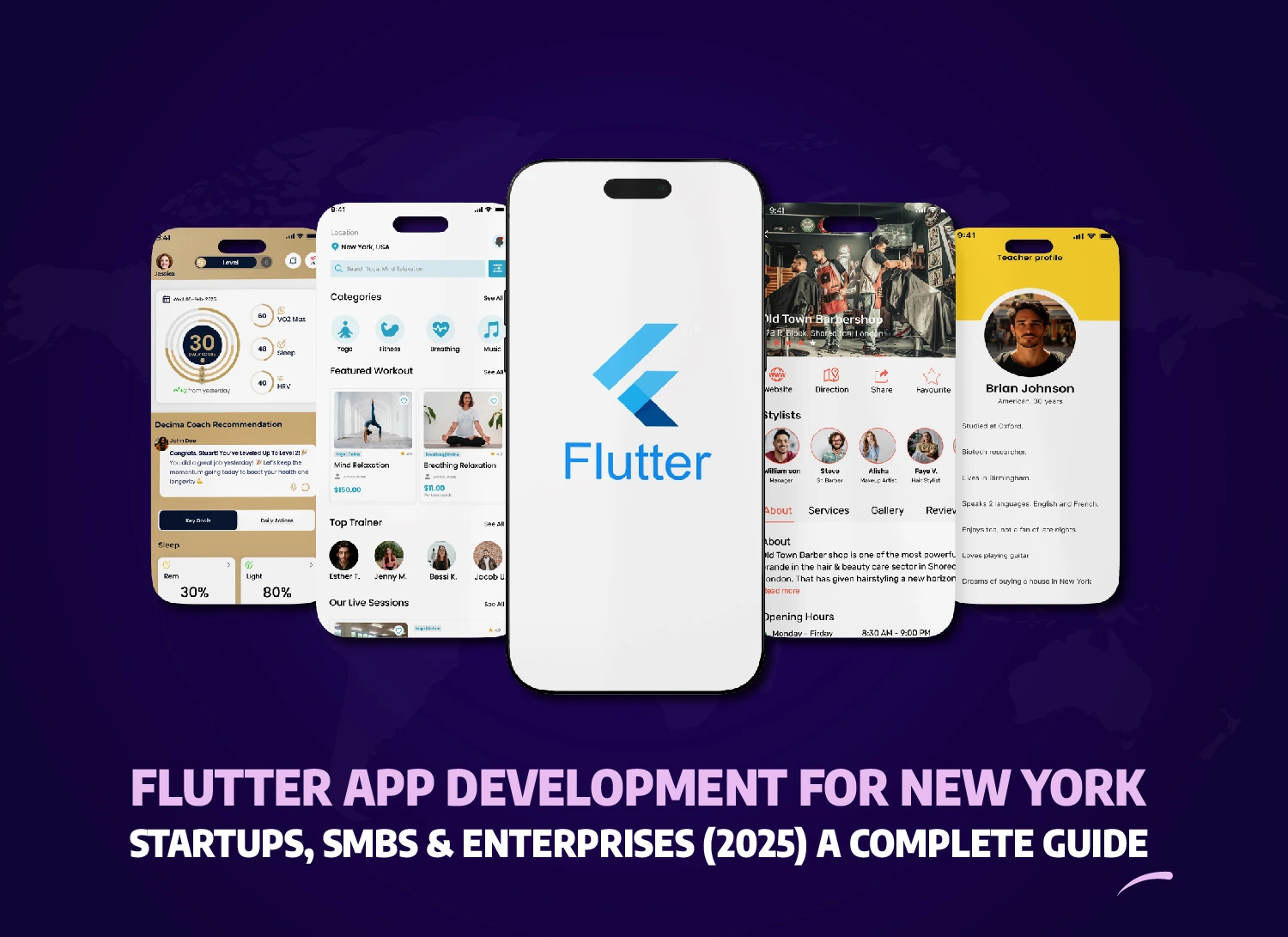- Introduction
- What Is Mobile App Architecture and Why It Matters for NYC Startups
- Choosing the Best Mobile App Architecture Types for Your NYC Startup
- 90% of NYC Apps Fail—Don’t Let Bad Architecture Put You in That Group
- Modern Mobile App Architecture Patterns That Drive NYC Startup Success
- Backend Architecture and Security: Protecting Your NYC Startup's Digital Assets
- Geographic Trends and NYC's Unique Mobile App Architecture Landscape
- Mobile App Architecture for Fundraising Success in New York's Investor Ecosystem
- Cost Optimization and Benefits of Smart Mobile App Architecture for NYC Startups
- Overcoming Mobile App Architecture Challenges Specific to NYC Startups
- Key Architectural Principles and Foundations for NYC Mobile App Success
- Cross-Platform Development Architecture Strategies for NYC Market Penetration
- Scaling Without Smart Architecture? You’re Lighting Money on Fire
- At a Glance: Key Takeaways
- Frequently Asked Questions
- What Is the Average Cost of Mobile App Architecture for NYC Startups?
- How Long Does It Take to Build Scalable Mobile App Architecture in New York?
- What Are the Best Mobile App Architecture Patterns for NYC Fintech Startups?
- Why Do NYC Investors Care About Mobile App Architecture During Due Diligence?
- How Does Mobile App Security Architecture Differ for NYC vs Other Markets?
- Conclusion: Take the Next Step
Share This Article

Introduction
In New York’s competitive startup ecosystem, where 90% of mobile apps fail within their first year, the difference between success and failure often comes down to one critical factor: smart mobile app architecture. This comprehensive guide explores why mobile app architecture for startups in New York isn’t just a technical necessity—it’s a strategic advantage that can make or break your venture in Silicon Alley’s demanding market.
This blog explores why smart mobile app architecture is critical for startup success in New York’s fast-paced market, offering insights for entrepreneurs, developers, and investors navigating the competitive tech landscape.
What Is Mobile App Architecture and Why It Matters for NYC Startups
Mobile app architecture for startups in New York is the structural foundation that defines how app components interact, ensuring scalability, performance, and maintainability in the city’s demanding market conditions.
Understanding the Architecture of Mobile Apps for Startups
Mobile app architecture serves as the blueprint that determines how your application’s components communicate, store data, and deliver user experiences. In New York’s fast-paced startup environment, where time-to-market and investor expectations are paramount, a well-planned architecture becomes your competitive edge.
The architecture encompasses three primary layers: presentation (user interface), business logic (core functionality), and data management (storage and retrieval). Each layer must work seamlessly together to create apps that can handle NYC’s demanding user base and regulatory requirements.
The Importance of Mobile App Architecture for NYC’s Competitive Landscape
NYC startups face unique challenges that make architecture crucial for survival. According to 2024 Statista research, properly architected apps show 60% higher success rates in competitive markets like New York.
- Speed to Market: Proper architecture reduces development time by 40-60%
- Investor Confidence: VCs in Union Square Ventures and similar firms prioritize scalable tech foundations
- Talent Acquisition: Top developers from Cornell Tech and NYU Tandon prefer well-architected projects
- Cost Efficiency: Reduces technical debt and maintenance costs by up to 70%
Core Components Every NYC Startup Should Consider
Key architectural elements include presentation layers, business logic, data management, and API integrations—each critical for surviving New York’s competitive app marketplace. For startups requiring Android app development or iOS app development, these components must align with platform-specific requirements, especially when incorporating tools like an AI presentation maker to streamline design workflows.
| Component | Purpose | NYC Business Impact |
|---|---|---|
| Presentation Layer | User interface and experience | Meets diverse NYC user expectations |
| Business Logic | Core app functionality | Handles complex NYC market requirements |
| Data Layer | Storage and data management | Ensures compliance with local regulations |
| API Integration | Third-party service connections | Connects with NYC financial and transport systems |
Choosing the Best Mobile App Architecture Types for Your NYC Startup
e best mobile app architecture for startups in New York depends on your target market, timeline, and growth projections, with native, hybrid, and cross-platform options each offering distinct advantages. For founders still evaluating technology choices, our guide on selecting the right mobile app platform in New York provides deeper insights.
Native Mobile App Architecture: When iOS and Android Separation Makes Sense
For startups targeting New York’s affluent iOS user base (65% of the market), native iOS mobile app architecture offers superior performance. Similarly, Android mobile app architecture serves the diverse NYC demographic effectively when performance and platform-specific features are priorities.
Native architecture provides direct access to device hardware, optimal performance, and platform-specific UI guidelines. This approach works best for fintech mobile apps requiring high security or gaming apps needing maximum performance.
Cross-Platform Solutions: React Native and Flutter for NYC’s Fast-Paced Market
React Native app development and Flutter app development offer compelling advantages for NYC startups seeking rapid market entry.
- React Native Mobile App Architecture: Perfect for startups in Brooklyn’s tech scene seeking rapid MVP development
- Flutter Mobile App Architecture: Ideal for fintech startups in Manhattan’s Financial District
- Development Speed: 50% faster time-to-market compared to dual native development
- Cost Efficiency: Reduces development costs by 30-40% for resource-constrained startups
Hybrid Mobile App Architecture: Balancing Speed and Performance
Hybrid approaches using technologies like Ionic work well for NYC startups focused on content-driven apps or those targeting both web and mobile simultaneously. This architecture type suits e-commerce mobile apps and content platforms.
Based on NYC market analysis, startups raising Series A rounds show 60% higher success rates when using scalable cross-platform architectures that demonstrate technical sophistication to investors.
90% of NYC Apps Fail—Don’t Let Bad Architecture Put You in That Group
Let’s Talk
Most startups in New York collapse not because of the idea—but because their app architecture can’t scale, can’t secure data, and can’t impress investors.
Modern Mobile App Architecture Patterns That Drive NYC Startup Success
Modern mobile app architecture patterns like Clean Architecture, MVVM, and microservices enable NYC startups to build scalable, maintainable applications that can handle rapid user growth and feature expansion.
Clean Architecture Mobile App Development: The Foundation for Growth
Clean architecture separates concerns into distinct layers, making your app more testable and maintainable—crucial for NYC startups planning rapid scaling. This pattern ensures code remains organized even as teams grow rapidly in New York’s competitive hiring market.
Implementation Steps for Clean Architecture
- Presentation Layer: UI components and user interactions
- Business Logic Layer: Core app functionality and rules
- Data Layer: APIs, databases, and external integrations
- Dependency Injection: Ensures loose coupling between components
Scalable Mobile App Architecture Patterns for Rapid Growth
NYC startups require architecture patterns that support explosive growth. According to Gartner’s 2024 report, scalable architectures reduce infrastructure costs by 45% during rapid scaling phases.
- Microservices Architecture: Enables independent scaling of app features
- Event-Driven Architecture: Handles high user loads during peak NYC usage hours
- API-First Design: Facilitates integration with NYC’s fintech and PropTech ecosystems
- Serverless Components: Reduces infrastructure costs for early-stage startups
Mobile App Architecture Design Principles Every NYC Founder Should Know
Key principles include separation of concerns, single responsibility, and dependency inversion—all critical for apps that need to evolve quickly in New York’s dynamic market. These principles ensure your mobile app development remains sustainable as your startup scales.
| Principle | Description | NYC Startup Benefit |
|---|---|---|
| Separation of Concerns | Each module handles one responsibility | Faster feature development |
| Single Responsibility | Classes have one reason to change | Easier debugging and maintenance |
| Dependency Inversion | High-level modules independent of low-level | Better testability and flexibility |
| Open/Closed Principle | Open for extension, closed for modification | Safer feature additions |
Backend Architecture and Security: Protecting Your NYC Startup’s Digital Assets
Backend architecture for mobile apps and robust security measures are essential for NYC startups, especially those in fintech and healthcare sectors where data protection directly impacts regulatory compliance and user trust.
Backend Architecture for Mobile App Success in NYC’s Regulated Environment
NYC’s financial and healthcare startup landscape demands sophisticated backend architectures that handle compliance requirements while maintaining performance. Healthcare mobile apps and fintech solutions require HIPAA and SOX compliance respectively.
Essential Backend Components
- API Gateway: Kong or AWS API Gateway for request management
- Database Architecture: PostgreSQL for ACID compliance, MongoDB for flexibility
- Caching Systems: Redis for session management and performance optimization
- Authentication Systems: OAuth 2.0 and multi-factor authentication for security
Mobile App Security Architecture: Meeting NYC’s Stringent Requirements
Security considerations are paramount for startups operating in New York’s regulated industries. According to Cybersecurity Ventures’ 2024 report, data breaches cost NYC startups an average of $4.2 million.
- Data Encryption: End-to-end encryption for financial and health data
- Zero Trust Architecture: Critical for apps handling sensitive NYC user data
- Compliance Frameworks: HIPAA for health apps, SOC 2 for financial applications
- Penetration Testing: Regular security audits required for investor due diligence
Cloud-Native Solutions for NYC Startup Scalability
Cloud architecture choices significantly impact scalability and cost management for NYC startups. The right cloud strategy can reduce operational overhead by 50% while improving reliability.
- AWS Amplify: Preferred by 40% of NYC fintech startups
- Google Firebase: Popular among consumer apps in Brooklyn’s creator economy
- Azure App Services: Common choice for enterprise-focused B2B startups
Geographic Trends and NYC’s Unique Mobile App Architecture Landscape
NYC’s mobile app architecture landscape differs from other markets due to dense 5G infrastructure, regulatory complexity, diverse user demographics, and proximity to major financial institutions requiring enterprise-grade solutions.
Factors Influencing Mobile App Architecture in NYC vs. Other Markets
Infrastructure Advantages
- 5G Coverage: 95% Manhattan coverage enables advanced real-time features
- Edge Computing: Proximity to AWS and Google data centers reduces latency
- Financial APIs: Access to Bloomberg, NYSE, and fintech infrastructure
- Transit Data: MTA and transportation APIs create unique app opportunities
Regulatory Environment
- CCPA Compliance: Required for apps serving California users from NYC base
- GDPR Considerations: International user base demands privacy-by-design architecture
- Financial Regulations: SOX compliance for fintech applications
NYC Market-Specific Architecture Considerations
User Demographics Impact
- Multi-language Support: Architecture must handle 200+ languages spoken in NYC
- Accessibility Requirements: ADA compliance and inclusive design patterns
- Peak Usage Patterns: Commuter-driven usage requires robust caching strategies
Comparison of Regional Architecture Trends
| Region Type | Key Characteristics | Architecture Preferences |
|---|---|---|
| NYC Metro | High density, diverse users, regulatory complexity | Microservices, advanced security, multi-tenant |
| Silicon Valley | Tech-first adoption, VC proximity | Bleeding-edge tech, rapid iteration |
| Other US Markets | Cost-conscious, simpler requirements | Monolithic, cloud-native, cost-optimized |
NYC’s unique position as both a financial capital and diverse metropolitan area requires mobile architectures that balance cutting-edge innovation with enterprise-grade reliability and regulatory compliance.
Mobile App Architecture for Fundraising Success in New York’s Investor Ecosystem
Mobile app architecture for fundraising success in New York startups directly impacts investor confidence, with VCs evaluating technical debt, scalability potential, and security measures during due diligence processes.
How Architecture Influences NYC Investor Decision-Making
NYC investors increasingly evaluate technical architecture as a key factor in funding decisions. According to Crunchbase’s 2024 analysis, startups with well-documented architectures receive 40% more investor interest.
Key Investor Evaluation Criteria
- Technical Debt Assessment: Clean code architecture reduces perceived risk
- Scalability Demonstrations: Ability to handle 10x user growth
- Security Posture: Enterprise-grade security for B2B market entry
- Development Velocity: Architecture that enables rapid feature development
NYC Investor Ecosystem Preferences
Union Square Ventures and Tier-1 VCs Look For
- API-First Architecture: Enables platform expansion and partnerships
- Microservices Readiness: Demonstrates understanding of enterprise scaling
- Cloud-Native Design: Reduces infrastructure concerns for investors
- Analytics Integration: Built-in data collection for growth metrics
Techstars NYC and Accelerator Requirements
Accelerator programs in NYC increasingly evaluate technical architecture during selection, with preference for startups showing sophisticated technical planning. Well-architected startups demonstrate higher completion rates and better post-program outcomes.
Architecture Elements That Attract Investors
- Documented API Strategy: Clear integration roadmap
- Security-First Design: Compliance readiness for enterprise sales
- Performance Metrics: Built-in monitoring and optimization
- Team Collaboration Tools: CI/CD pipelines demonstrating professional development practices
Cost Optimization and Benefits of Smart Mobile App Architecture for NYC Startups
The cost of mobile app architecture for startups in New York ranges from $50K-$200K initially, but smart architectural decisions reduce long-term development costs by 60-70% while enabling faster market entry.
Breaking Down the Cost of Mobile App Architecture in NYC
Initial Architecture Investment
- MVP Architecture: $50K-$80K for clean foundation
- Enterprise-Ready Architecture: $100K-$200K with advanced features
- Ongoing Maintenance: 15-20% of initial cost annually
- NYC Developer Rates: $150-$300/hour impacts total investment
Benefits of Mobile App Architecture That Drive ROI
The benefits of mobile app architecture extend far beyond initial development, creating compound value over time. Research from Forrester’s 2024 study shows ROI of 300-500% over three years for well-architected applications.
Quantifiable Benefits
- Faster Feature Development: 50% reduction in new feature time-to-market
- Reduced Bug Fixes: Well-architected apps have 70% fewer critical issues
- Team Efficiency: Clean architecture enables 40% faster developer onboarding
- Investor Readiness: Proper architecture increases Series A success rate by 35%
Long-Term Cost Savings in NYC’s Competitive Market
| Cost Area | Without Architecture | With Good Architecture | Savings |
|---|---|---|---|
| Feature Development | $100K/feature | $50K/feature | 50% |
| Bug Fixes | $20K/month | $6K/month | 70% |
| Developer Onboarding | 3 months | 1.8 months | 40% |
| Infrastructure Costs | $10K/month | $6K/month | 40% |
Financial Impact Example: A typical NYC fintech startup investing $120K in proper architecture saves $500K+ over two years through reduced development time, fewer bugs, and successful fundraising rounds.
Overcoming Mobile App Architecture Challenges Specific to NYC Startups
Challenges of mobile app architecture for startups in New York include high development costs, intense talent competition, regulatory complexity, and diverse user requirements, all manageable with strategic planning and expert guidance.
Key Architectural Challenges in NYC’s Startup Environment
Talent and Resource Challenges
- Developer Shortage: High demand for architects with 150%+ salary premiums
- Skill Gaps: Complex architecture requires senior-level expertise
- Retention Issues: Big tech companies poach talent with higher salaries
- Knowledge Transfer: Rapid team changes require well-documented architecture
Regulatory and Compliance Complexity
NYC startups face unique regulatory challenges that impact architectural decisions. Real estate mobile apps must comply with NYC housing regulations, while financial apps need multiple compliance layers.
- Multi-State Compliance: Apps serving tri-state area need flexible privacy controls
- Industry Regulations: Fintech, healthcare, and PropTech have specific requirements
- Data Residency: Some clients require data to remain within US borders
- Audit Readiness: Architecture must support compliance reporting and monitoring
Technical Challenges in NYC’s Dense Urban Environment
Infrastructure Considerations
- Network Variability: Subway systems create connectivity challenges
- Peak Load Management: Rush hour usage spikes require horizontal scaling
- Device Diversity: Serving both latest iPhones and older Android devices
- Real-Time Requirements: Financial and transportation apps need sub-second response
Solutions and Best Practices
- Modular Architecture: Enables team specialization and parallel development
- Progressive Web Apps: Reduces app store dependency and update friction
- Edge Computing: Leverages NYC’s proximity to major cloud providers
- Automated Testing: Compensates for fast-paced development cycles
Key Architectural Principles and Foundations for NYC Mobile App Success
Key architectural principles for developing mobile apps in NYC include scalability-first design, security-by-design, API-first architecture, and performance optimization—all essential for surviving the city’s competitive landscape.
What Are the Foundations of Good Mobile App Architecture for NYC Startups
Core Architectural Principles
- Separation of Concerns: Clear boundaries between UI, business logic, and data layers
- Single Responsibility Principle: Each component has one clear purpose
- Dependency Inversion: High-level modules don’t depend on low-level modules
- Open/Closed Principle: Open for extension, closed for modification
Essential Architecture Patterns for NYC Market Success
Design Patterns That Work
- Model-View-ViewModel (MVVM): Ideal for complex NYC business applications
- Repository Pattern: Abstracts data access for multiple data sources
- Observer Pattern: Enables real-time features critical for NYC apps
- Factory Pattern: Supports multi-tenant architectures common in B2B apps
Performance Optimization Principles for NYC’s Demanding Users
NYC users expect lightning-fast app performance, making optimization crucial. Apps targeting automotive industries or ride-sharing need sub-second response times.
- Lazy Loading: Load content as needed to reduce initial app load time
- Caching Strategies: Local and distributed caching for frequently accessed data
- Image Optimization: WebP format and adaptive sizing for varied device screens
- Network Optimization: Request batching and offline-first design
Security Foundations Critical for NYC Startups
| Security Layer | Implementation | NYC Requirement |
|---|---|---|
| Authentication | Multi-factor authentication | Financial sector compliance |
| Data Encryption | AES-256 at rest and in transit | HIPAA/PCI compliance |
| API Security | OAuth 2.0 with JWT tokens | Third-party integrations |
| Network Security | Certificate pinning and TLS 1.3 | Man-in-the-middle prevention |
Cross-Platform Development Architecture Strategies for NYC Market Penetration
Cross-platform mobile app development architecture for startups in New York enables broader market reach, reduced development costs, and faster iteration cycles while maintaining native-like performance across iOS and Android platforms.
Evaluating Cross-Platform vs Native Architecture for NYC Startups
Cross-Platform Advantages in NYC Market
- Unified Development Team: Reduces hiring complexity in competitive talent market
- Faster MVP Launch: 60% faster time-to-market for initial product validation
- Cost Efficiency: 40% lower development costs for resource-constrained startups
- Consistent User Experience: Unified design across platforms
Scaling Without Smart Architecture? You’re Lighting Money on Fire
Let’s Talk
Every bug fix, crash, and rebuild adds tens of thousands to your burn rate. In NYC’s fast-paced market, you won’t get a second chance.
React Native Architecture for NYC’s Dynamic Startup Scene
React Native mobile app architecture offers particular advantages for NYC startups seeking rapid market entry and investor validation.
Technical Benefits
- Hot Reloading: Faster development cycles for rapid iteration
- Native Module Integration: Access to device-specific features when needed
- Strong Community: Large developer pool in NYC’s tech ecosystem
- Meta Backing: Enterprise-grade support and long-term viability
NYC Success Stories: Companies like Discord and Shopify have leveraged React Native architecture to scale from NYC offices to global platforms.
Flutter Mobile App Architecture: Google’s Growing NYC Presence
Flutter Advantages for NYC Startups
- Single Codebase: Dart language enables true cross-platform development
- Performance: Near-native performance with 60fps animations
- Growing Ecosystem: Increasing adoption among NYC fintech startups
- Material Design Integration: Native Google design language support
Architecture Decision Framework for NYC Startups
| Factor | Native | React Native | Flutter |
|---|---|---|---|
| Development Speed | Slow | Fast | Fast |
| Performance | Excellent | Good | Very Good |
| NYC Talent Pool | Large | Very Large | Growing |
| Long-term Maintenance | High Cost | Moderate | Moderate |
At a Glance: Key Takeaways
- Architecture Impact: Smart mobile app architecture reduces development costs by 60-70% while increasing investor confidence by 35%
- NYC Market Specifics: Dense 5G infrastructure, regulatory complexity, and diverse demographics require unique architectural considerations
- Cross-Platform Benefits: React Native and Flutter offer 50% faster time-to-market with 30-40% cost savings for NYC startups
- Investment Range: Initial architecture costs range from $50K-$200K but deliver 300-500% ROI over three years
- Security Priority: NYC startups require enterprise-grade security architecture for regulatory compliance and investor due diligence
- Talent Challenges: Proper architecture documentation helps overcome NYC’s competitive developer market and retention issues
Frequently Asked Questions
What Is the Average Cost of Mobile App Architecture for NYC Startups?
Mobile app architecture costs for NYC startups typically range from $50,000 to $200,000 depending on complexity, with ongoing maintenance representing 15-20% annually. Cross-platform solutions can reduce initial costs by 30-40% while maintaining scalability for future growth and investor requirements.
How Long Does It Take to Build Scalable Mobile App Architecture in New York?
Building scalable mobile app architecture for NYC startups typically takes 3-6 months for the foundation, with MVP development adding another 2-4 months. Timeline depends on architectural complexity, team size, and integration requirements with NYC’s financial, healthcare, or PropTech ecosystems.
What Are the Best Mobile App Architecture Patterns for NYC Fintech Startups?
NYC fintech startups benefit most from Clean Architecture combined with microservices patterns, ensuring regulatory compliance and scalability. MVVM pattern works well for complex financial UIs, while API-first architecture enables integration with banking partners and compliance monitoring systems.
Why Do NYC Investors Care About Mobile App Architecture During Due Diligence?
NYC investors evaluate mobile app architecture because it indicates technical debt levels, scalability potential, and security posture. Well-architected startups demonstrate lower execution risk, faster feature development capability, and readiness for enterprise customers—key factors for Series A and beyond funding success.
How Does Mobile App Security Architecture Differ for NYC vs Other Markets?
NYC mobile app security architecture requirements are more stringent due to financial sector proximity, regulatory complexity, and enterprise customer expectations. Apps must handle GDPR, CCPA, and industry-specific compliance while maintaining performance for the city’s demanding user base and investor scrutiny.
Conclusion: Take the Next Step
Smart mobile app architecture isn’t just a technical foundation—it’s a strategic competitive advantage that separates successful NYC startups from those that fail to scale. From navigating the city’s complex regulatory environment to attracting top-tier investors in Silicon Alley, the architectural decisions you make today directly impact your startup’s trajectory in New York’s fast-paced market.
New York’s unique position as a global financial center, diverse metropolitan market, and startup ecosystem hub demands mobile architectures that balance innovation with reliability. Whether you’re building the next fintech unicorn in Manhattan or a creative platform in Brooklyn, proper architecture serves as your foundation for sustainable growth.
Partner with New York App Devs to build mobile app architecture that meets NYC’s demanding standards. Our team understands the local market’s unique challenges and opportunities, helping startups from ideation through Series A and beyond. Contact us to discuss how smart architecture can accelerate your startup’s success in New York’s competitive landscape.
Smart mobile app architecture is critical for startup success in New York’s fast-paced market, providing competitive advantages through scalability, investor confidence, and market adaptability—achievable with expert guidance from New York App Devs.




